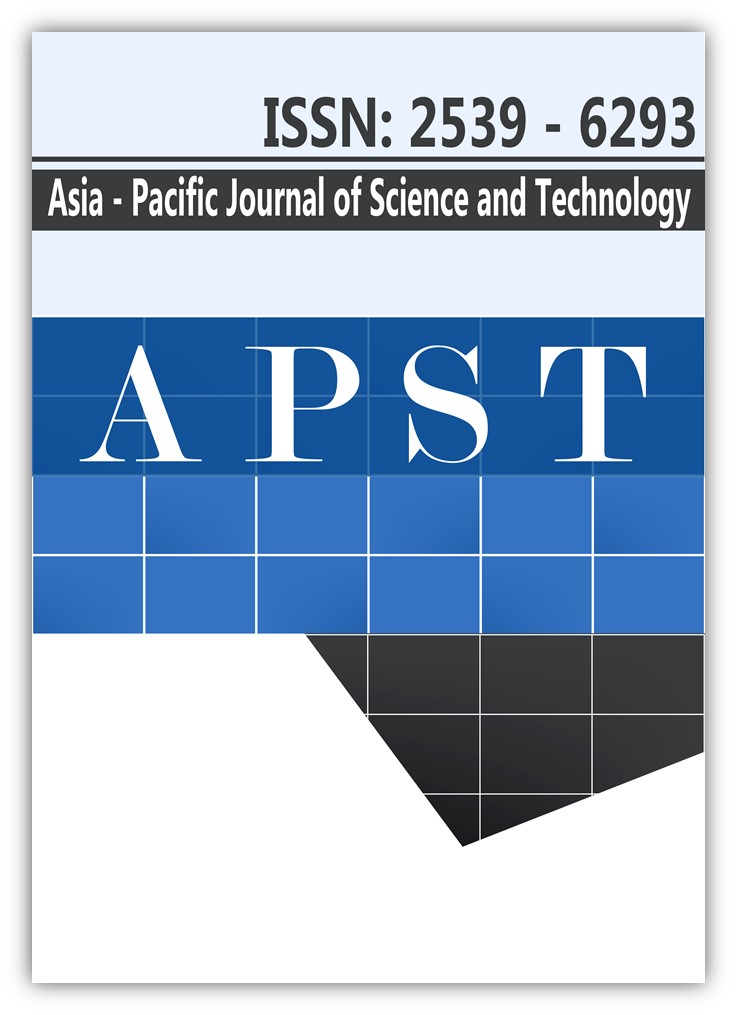Geotechnical investigation of the 2017 earth-filled embankment failures in Thailand
Main Article Content
Abstract
This present study was to investigate the potential geotechnical causes of the failures of two earth-filled embankments occurred in 2017 in Thailand. The Huai Sai Kamin embankment dam was the first failure that occurred on July 28th. The Nong Sano reservoir was the second failure that occurred on October 18th. Geological, geotechnical and hydrological data were collected and analyzed together meteorological data. In addition, site visits were performed to collect soil samples for testing. The results show that the embankment of the Huai Sai Kamin dam was well compacted of clayey sand (SC) over an alluvial soil and two tributaries, Huai Sai tributary and Huai Nam Bo tributary. Water overtopping during the tropical depression, Sonca caused the Huai Sai Kamin embankment to breach. The breach occurred at two sites. One site was at the remnant of Huai Nam Bo tributary and the other site was at the irrigation conduit. An inadequate spillway capacity and inadequate maintenance were the causes of such water overtopping. The embankment of the Nong Sano reservoir was compacted of sandy lead clay (CL) over the sandstone, siltstone and mudstone of the Khorat Group. The Nong Sano embankment was breached due to the embankment that contained a significant amount of dispersive clay. Rehabilitation of the Nong Sano reservoir should consider the problem of the soil type used for constructing an embankment, while the rehabilitation of the Huai Sai Kamin dam should consider a spillway capacity and a proper maintenance.
Article Details
References
[2] Water technology [Internet]. 2013 [cited 2019 Apr 12]. The world’s oldest dams still in use. Available from: https://www.water-technology.net/features/feature-the-worlds-oldest-dams-still-in-use/.
[3] Royal Irrigation Department [Internet]. 2019 [cited 2019 Apr 12]. Available from: https://kmcenter. rid.go.th/kmc16/wichakarn/dam/chawpaya.htm.
[4] Hydro and Agro Informatics Institute [Internet]. 2018 [cited 2018 Jun 6]. Hydro situation of large and medium scale dams. Available from: https://www.thaiwater.net/DATA/REPORT/php/show_sm_dam.php.
[5] 2017 Pacific typhoon seoson. Wikipedia Online (n.d) [Internet]. 2019 [cited 2019 May 4]. Available from: https://en.wikipedia.org/wiki/2017_Pacific_typhoon_season.
[6] Record water events, Hydro Agro Informatics Inst [Internet]. 2018 [cited 2018 June 6]. Available from: https://www.thaiwater.net/current/2017/DOKSURIsep2017/DOKSURI2017.html.
[7] Record water events, Hydro Agro Informatics Inst [Internet]. 2018 [cited 2018 June 6]. Available from: https://www.thaiwater.net/current/2017/SONCAjuly2017/sonca.html.
[8] Record water events, Hydro Agro Informatics Inst [Internet]. 2018 [cited 2018 June 6]. Available from: Thttps://www.thaiwater.net/current/2018/SON-TINH/Son-Tinh.html.
[9] Google Map, Khamin, Sakon Nakhon, Street view [Internet]. 2015 [cited 2018 Jun 2]. Available from: https://www.google.co.th/maps/@17.219719,104.0293357,3a,40.6y,299.73h,94.19t/data=!3m6!1e1!3m4!1sS5FU3bHGZ5QTmk9qkCaxtg!2e0!7i13312!8i6656.
[10] Thairath Online [Internet]. 2017 [cited 2018 Jun 4]. No failure at Huai Sai Kamin dam. Available from: https://www.thairath.co.th/content/1019185.
[11] Thairath Online [Internet]. 2017 [cited 2018 Jun 4]. Pictures of dry reservoir after flash flooding. Available from: https://www.thairath.co.th/content/1022222.
[12] Thai PBS News [Internet]. 2017 [cited 2018 Jun 4]. Team of volunteer engineers from engineering institute of Thailand helped to examine 130 vulnerable earth-filled dams. Available from: https://news.thaipbs. or.th/content/264898.
[13] Google Map, Phaniat, Lopburi, Street view [Internet] 2014 [cited 2018 Jun 25]. Available from: https://www.google.co.th/maps/@15.0315871,100.789227,3a,75y,79.01h,84.82t/data=!3m6!1e1!3m4!1sRKuSKyKMPIEvxoSOnoHQwg!2e0!7i13312!8i6656!5m1!1e4.
[14] Komchadluek Online [Internet]. 2017 [cited 2018 Jun 28]. Failure of reservoir in Kasetsart University, Lopburi. Available from: https://www.komchadluek.net/news/agricultural/299351.
[15] Google Map, Amphoe Muang Dsitrict, Sakon Nakhon [Internet] 2016 [cited 2018 Jun 3]. Available from: https://www.google.co.th/maps/@17.1880829,104.0225853,13.04z/data=!5m1!1e4.
[16] Gojanan, J and Charnchuwong, W. Geologic map of Changwat Sakon Nakhon Quadrangle, Sheet 5843 III, Scale 1:50,000. Department of Mineral Resources. 2008.
[17] Rukyou R. Special project on the evaluation of potential of medium scale reservoir project in Sakon Nakhon province. Kasetsart University. 1994.
[18] Phudanpan, T [Internet]. 2017 [cited 2018 Jun 5]. Report on flooding at Huai Sai Kamin on July 29th, 2017. Available from: https://www.youtube.com/watch?v=y5UgVx3aCOI.
[19] Nakornsri, N. Geologic map of Amphoe Ban Mi, ND 47-4, Scale 1:250,000. Department of Mineral Resources. 1977.
[20] Knodel, CP. Characteristics and problems of dispersive soils. U.S. Department of the Interior, Research and Laboratory Services Division, Materials Engineering Branch. 1991.
[21] Federal Emergency Management Agency (FEMA). Evaluation and monitoring of seepage and internal erosion, Interagency committee on dam safety (ICODS), FEMA P-1032. 2015.
[22] Aitchison, GD, and Wood, CC. Some interactions of compaction, permeability, and post-construction deflocculation affecting the probability of piping failures in small dams. Proceedings, 6th International Conference on Soil Mechanics and Foundation Engineering; 1965 Sep 8-15; Montreal Canada: University of Toronto Press; 1965;442-446.
[23] Mairaing, W and Pintabut, W. Seepage analysis of Mun Bon dam by finite element method. Kasetsart Engineering Journal. 1996;27:131-151.
[24] Meteorological Department [Internet]. 2018 [cited 2018 Jun 8]. Online report of amount of rainfall. Available from: https://hydromet.tmd.go.th/Reports/report-rf-province-month.aspx.
[25] Nation TV Online [Internet]. 2017 [cited 2018 Jun 10]. Overflow at Huai Sai Kamin spillway. Available from: https://www.nationtv.tv/main/content/378515633/.
[26] Google Earth, Khamin, Sakon Nakhon, Thailand [Internet] 2015 [cited 2018 Jun 10].
[27] Satarugsa, P, Sangchupoo, S, Uphatum, P and Buanark, M. Assessment of an internal structure of an earth-filled embankment with 2-D resistivity technique. In: Wang, X, Xia, J, Yan, J, and Xu, Y., editors. Proceeding of the 4th International Conference on Environmental and Engineering Geophysics; 2010 Jun 14-19; Chengdu, China; 2010;318-324.
[28] Satarugsa, P and Sangchumpoo, S. Applied 2-D resistivity survey for determination of an internal structure of an earth-filled embankment of irrigation reservoirs in the Northeastern Thailand. KKU Res J. 2011;16(6):655-667.
[29] Google Map, Khok Samrong District, Lopburi, [Internet]. 2017 [cited 2018 Jun 22]. Available from: https://www.google.co.th/maps/@15.0572113,100.7512031,6081a,35y,90h,38.32t/data=!3m1!1e3!5m1!1e4.


